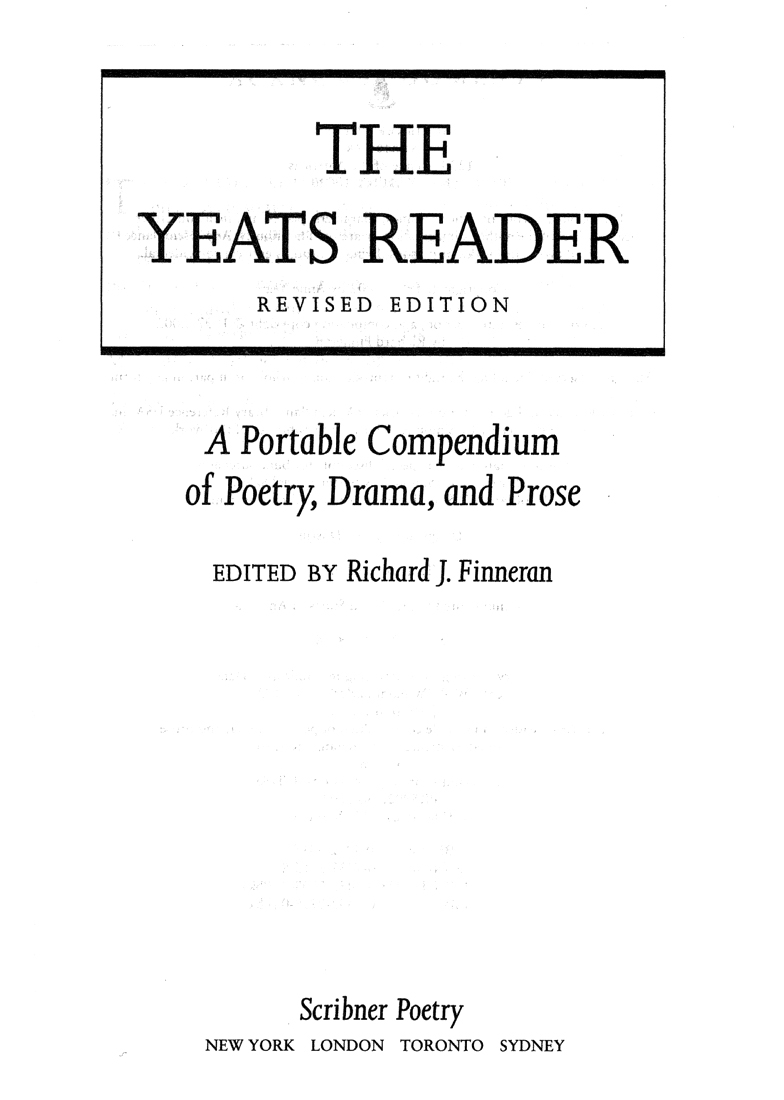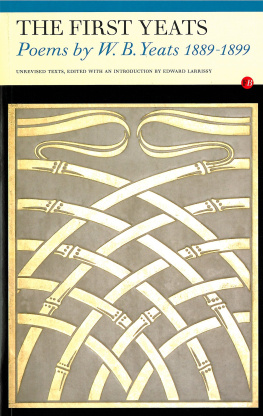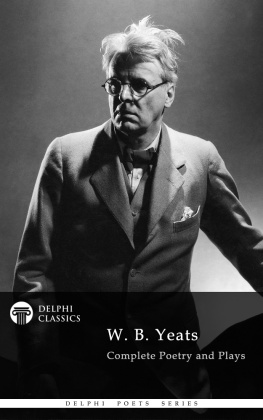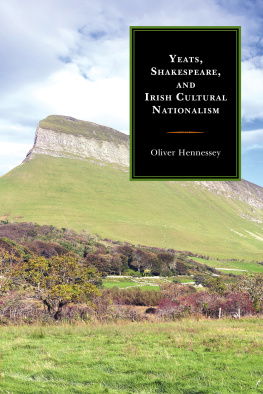Thank you for purchasing this Scribner Poetry eBook.
Sign up for our newsletter and receive special offers, access to bonus content, and info on the latest new releases and other great eBooks from Scribner Poetry and Simon & Schuster.

or visit us online to sign up at
eBookNews.SimonandSchuster.com
We hope you enjoyed reading this Scribner Poetry eBook.
Sign up for our newsletter and receive special offers, access to bonus content, and info on the latest new releases and other great eBooks from Scribner Poetry and Simon & Schuster.

or visit us online to sign up at
eBookNews.SimonandSchuster.com



SCRIBNER POETRY
SCRIBNER 1230 Avenue of the Americas New York, NY 10020 www.SimonandSchuster.com
This book is a work of fiction. Names, characters, places, and incidents either are products of the authors imagination or are used fictitiously. Any resemblance to actual events or locales or persons, living or dead, is entirely coincidental.
Copyright 1997, 2002 by Anne Yeats
Editorial notes, introduction, and compilation copyright 1997, 2002 by Richard Finneran
All rights reserved, including the right of reproduction in whole or in part in any form.
SCRIBNER POETRY and design are trademarks of Macmillan Library Reference USA, Inc., used under license by Simon & Schuster, the publisher of this work.
Designed by Jenny Dossin
Text set in Sabon
Manufactured in the United States of America
5 7 9 10 8 6
Library of Congress Cataloging-in-Publication Data
Yeats, W. B. (William Butler), 18651939
[Selections. 2002]
The Yeats reader : a portable compendium of poetry, drama, and prose /
edited by Richard J. Finneran.Rev. ed.
p. cm.
1. IrelandLiterary collections. I. Title
PR5902.F56 2002
821.8dc21 2002070670
ISBN-13: 9780-7432-3315-6
ISBN-10: 0-7432-3315-8
ISBN-13: 9780-7432-2798-8 (Pbk)
ISBN-10: 0-7432-2798-0 (Pbk)
ISBN-13: 978-1-45167-376-0 (eBook)
ACKNOWLEDGMENTS
T HIS REVISED EDITION includes fifty-seven additional poems and corrects some texts to accord with recently published volumes in the Scribner/Palgrave Collected, Edition of the Works of W. B. Yeats. In addition, an Appendix offers the original versions of several poems, so that a reader can gain a sense of Yeatss constant process of revision (and not only of his early poetry). I am again indebted to Professor George Bornstein for his suggestions and to Sarah McGrath of Scribner for her support of the project.
Wildwood, Missouri
15 March 2002
R.J.F.
CONTENTS
[Dates and order follow The Plays (2001)]
PREFACE
T HE REPUTATION of William Butler Yeats as one of the major writers in English of the twentieth century of course rests primarily on his poetry. But while it was the most central, poetry was only one of the many genres in which Yeats worked. The purpose of The Yeats Reader is to present a selection of his poems accompanied by a sampling of his other work. This material is not only a useful adjunct to an understanding of the poetry but also often a substantial achievement on its own terms.
Had Yeats not been first and foremost a poet, he doubtless would have been a dramatist. Indeed, in 1917 he confessed that I need a theatre; I believe myself to be a dramatist; I desire to show events and not merely tell of them;... two of my best friends were won for me by my plays, and I seem to myself most alive at the moment when a room full of people share the one lofty emotion. In fact, from the end of the century forward, Yeats was very much a practicing dramatist, and many of his plays were significantly strengthened as a result of their first production, often at the Abbey Theatre in Dublin. The. selection included here ranges from the early nationalistic Cathleen ni Houlihan, a collaboration with Lady Gregory which Yeats would point to when criticized for being insufficiently committed to the struggle against English rule in Ireland; to At the Hawks Well, the first play showing the influence of the Japanese Noh drama to which he was introduced by Ezra Pound; to The Words upon the Window-pane, which closely follows the conventions of the drawing-room drama, only to undercut them by the introduction of the supernatural.
but some diaries and his account of the Nobel Prize offer glimpses of the later years. Moreover, a comparison of Memoirs, a draft of part of his autobiography, with the published version discloses what he chose not to disclose, as well as demonstrating that even in this supposedly most personal of genres, Yeats was at least as interested in the artistry of his work as in its factual accuracy.
Yeats also tried his hand at prose fiction. His third separate publication, John Sherman and Dhoya (1891), consisted of a realistic novelette and an heroic Irish tale, and the latter would provide the model for most of his later endeavors in the genre. His work ranges from fairy and folk tales, often collected with the assistance of Lady Gregory, to occult and esoteric stories such as The Adoration of the Magi. Although Yeatss work in prose fiction was essentially completed in the early years of the century, he would resurrect some of its characters for both his poetry and his philosophical prose in his later years.
Indeed, there is a continual interchange between Yeatss creative work and his critical writings. In the early years he produced a considerable body of reviews and journalistic writings. By the turn, of the century, however, his critical writings took on a more substantial form, with essays on such subjects as William Blake (one of his masters), The Symbolism of Poetry, or the contemporary condition of the English and Irish stage. In 1918 he published Per Amica Silentia Lunae, a summary of his thinking to date on the relationship between the Self and the Anti-Self and between the Self and the World, particularly the archetypal repository of images on which the artist draws. But even before Per Amica was in print, his wife had begun the automatic writing and related psychical activities which provided the basis for A Vision, first published in 1925 and revised in 1937, Yeatss fundamental statement on such topics as the nature of human personality, the fate of the soul between lives, and the cyclical basis of history. In 1937 he composed three prefaces for the Scribner Edition, an unpublished seven-volume edition of his essential canon: of these, the Introduction to the first volume is a seminal statement of his objectives, as a writer.
Whether within or across the various genres which Yeats essayed, arguably a fundamental characteristic is the refusal to be satisfied with what had been accomplished. Any published text was always available to be revised for its next printing, and often was. If a particular kind of writing had beenas he wrote in What Then?to perfection brought, such was only the occasion to search for a new style, a new consummation (it was not for want of a better title that the volume of poetry published a month before his seventy-third birthday was called simply
Next page









